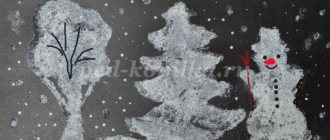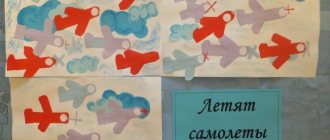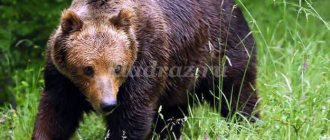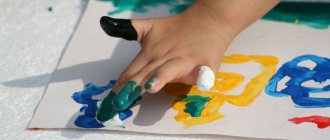Lesson 8. Drawing “Beautiful stairs”
Program content. Teach children to draw lines from top to bottom; carry them straight without stopping. Learn to put paint on a brush, dip the entire bristles into the paint; remove the excess drop by touching the edge of the jar with the lint; rinse the brush in water, dry it with a light touch of a cloth to pick up paint of a different color. Continue introducing flowers. Develop aesthetic perception.
Methodology of conducting the lesson. Remind the children that they saw ladders on the site during a walk, in the hall during a physical education lesson. If possible, look at the climbing ladders with the children, pay attention to how bright and beautiful they are.
Tell the children that today they will draw beautiful stairs. Invite them to show with their hands in the air the direction of the lines of the ladder. Show on a piece of paper pinned to the board how to draw lines together with the entire bristle of the brush. Call one of the guys to the board and ask them to draw a ladder. Then show the children how to rinse the brush, dry it on a cloth, and only then apply another paint.
Place the finished drawings on the board (table) and examine them with the children. When viewing works, highlight beautiful color combinations.
Materials. Paper 1/2 landscape sheet size (or A4 size); gouache paints of four colors (for different tables, paints of two colors in different combinations, beautifully combined), jars of water, brushes, paints (for each child).
"Ladder"
Vlad K., 2nd junior group
Connections with other activities and activities. Take a look at the ladders on the site and in the gym with your children. Pay attention to the even bases of the stairs and steps. Include hand movements in parts of the ladder in the process of viewing, emphasizing that they are straight and even.
Option. Drawing “Beautiful striped rug”
Program content. Teach children to draw lines from left to right, to move the brush continuously along the pile; put paint on the brush, rinse the brush thoroughly; paint carefully with another paint, without going into the places where it has already been painted. Develop color perception and consolidate knowledge of colors.
Methodology of conducting the lesson. Attach 3-4 striped (two-color) rugs to a board or large sheet of paper. Draw children's attention to the direction of the stripes. Remove sample mats.
Show children how to draw a striped rug: first draw stripes of the same color from left to right, at a short distance from each other (emphasize the continuity of movement, timely dip the brush in the paint), then rinse the brush well, dry it on a cloth, dip it in another paint and draw stripes of a different color between the already drawn stripes.
At the end of the lesson, look at all the drawings, note the variety of color combinations, and say that the rugs turned out very beautiful.
Admire the works with the guys. You can beautifully arrange the pictures by color.
Materials. 3-4 striped two-color rugs. Square sheets of paper; gouache paints (two different, well-matching paints for each table); jars of water, brushes, rags (for each child).
Connections with other activities and activities. Clarify children's knowledge about colors in educational games. Look at beautiful striped fabrics, runners, scarves.
Summary of a drawing lesson on the topic: Ladder
Orta tobyndagy uyimdastyrylgan oku kyzmetіnіn abstracts
Summary of organized educational activities for the middle group
Event description/Date: 17.10.2019
Tarbieshi/Teacher: Tekaeva V.Yu.
Bilim take salas/Educational field: Creativity
Pәn/Subject: Drawing
otpeli takyryp / Cross-cutting theme: “What does bread come from”
Takyryby/Topic: “Ladder»
Maksattaras/Goals:
Tarbielik – educational:
Cultivating a desire to draw with paints and brushes
Damytushylyk – developing:
Develop hand-eye coordination by placing images throughout the sheet
Oqytu – educational:
Develop skills in the ability to depict simple objects. Teach children to paint with a brush; Rhythmically apply lines and strokes using the dipping method.
Pedagogical technology/Pedagogical technologies:
gaming, health-saving, TRIZ
Resurstarmen kamatamasyz etu/Resource support:
½ album sheet, paints, brushes
Bilingual component/Bilingual component:
baspaldak – staircase
Uyimdastyrylgan oku kyzmetinin Barysy
Progress of organized educational activities
Ұyimdastyrushylyk kezeni/Organizational point:
He asks the children if everyone knows the fairy tale “Kolobok”. Next he offers to briefly tell the tale, noting the actions of the characters/
Negіzi bolіmі/Main part:
- So, guys, I’ll tell you another story about the bun. Our guest is a kolobok (shows the kolobok) ,
lay on the window and rolled through the forest.
He saw a tower (shows the tower),
and he wanted to sit on the tower.
But he didn't know how to get there. Shall we help him, guys? (they show a desire to help the bun)
Asks the children how to get up there. Shows a toy ladder and draws the children’s attention to the long vertical and short horizontal sticks.
Bilingual component:
baspaldak - staircase
Asks what other staircases there are and where we can see them. He notes that ladders come in different varieties and are made from different materials: wood, stones, iron. Fizminutka:
We stomp our feet, stomp-stomp-stomp! We clap our hands, Clap-clap-clap! We shake our heads, And we turn our heads. We raise our hands, We lower our hands, We give our hands And we run around.
- Let's draw a ladder. Let's show you drawing in the air. Organizes children at work places.
Individual work
with Bogdan, Yaroslav, Sanzhar: helps to draw
Korytynda’s ladder/Final part:
- Now our bun will be able to climb onto the turret. Well done guys, they helped him. He is very happy! Let's show him how he will climb the ladder.
D/i: “The Turret and the Gingerbread Man”
On the topic: methodological developments, presentations and notes
Goal: continue to teach children to hold the hand correctly, without straining the muscles or squeezing the fingers too tightly; achieve free movement of the hand and brush while drawing. Continue learning how to draw paint on.
Summary of the lesson on drawing “Snails” in the younger group. To develop children’s ability to hold a pencil correctly, consolidate knowledge of colors (red, yellow, green, blue), and cultivate interest in images.
Drawing a dandelion using the “poke” method.
The following tasks are solved at the GCD: Teach children to draw paths to the balls, using the ability to draw straight horizontal lines in a continuous, continuous line. Continue to teach children to distinguish and name.
Develop the ability to draw beautiful stairs.
Summary of a drawing lesson in the younger group on the topic “Acquaintance with Dymkovo toys. Drawing patterns."
Summary of a drawing lesson in the senior group on the topic “Beautiful birds - bullfinches, titmice.”
Source
Drawing techniques for children of the second younger group
There are quite a few types and techniques of drawing available to children aged 3–4 years. Below are the most interesting and useful of them.
Finger drawing
This simple and fun technique is ideal for introducing fine art. It is quite simple to implement, gives the child freedom of action and is easy to master in a playful way. For the first time, you can try leaving fingerprints on paper using different colors. Once the child understands the meaning of this action, you can allow him to draw with his fingers at his own discretion.
Important! The teacher must first demonstrate this method himself. After the child has shown interest, he is invited to do the same. If the baby does not demonstrate readiness, the lesson should be postponed.
Once this technique is mastered, you can use it to create narrative drawings. To do this, before class, outline images of the sun, a balloon, a house or other objects are drawn on sheets of paper with a marker. Then the children are asked to use their fingerprints to fill the space inside the finished drawing.
Drawing with palms and fists
Once the finger technique is mastered, children can easily move on to drawing with their palms. An adult needs to be creative and think through the plot of the drawing in advance. The handprint can be the rays of the sun, some animal, flower, tree or house. After the paint on the paper has dried, eyes, ears, leaves or other elements that make the drawing recognizable are drawn in with felt-tip pens.
Drawing with palms
Drawing with stamps and signets
Drawing stamps can be purchased at art stores or made independently from natural materials, cardboard, foam sponge, cotton swabs, even potatoes or cauliflower. This technique makes a special impression on children due to its simplicity of execution and spectacular results. At the first stage, you can let children master the use of a stamp in a free form, and then offer a plot drawing.
Stamps
Blotography
This method will introduce the child to the properties of paints. Applying watery blots and streaks to the paper will reveal an interesting mixture of colors. At this moment, you can draw the child’s attention to the fact that two different colors, when mixed, can give a third, completely new one. You can also experiment with thickness - apply streaks and splashes first with liquid and then with thicker paint. After the drawing has dried, using felt-tip pens or pencils, you can shape the blots into an image of space, landscape, season (for example, if yellow and red colors predominate - autumn, blue and white - winter).
Blotography
Monotype
An effective technique that creates symmetrical patterns. A sheet of paper is folded in half and paint is applied to one half in the form of blots, or, if the plot is thought out in advance, along the contour outlined in pencil. Then the paper is folded, smoothed with the palm of your hand and straightened. The resulting print is allowed to dry, after which the necessary contours and elements are drawn in with felt-tip pens. It is so easy to depict objects such as a butterfly, an airplane, a book.
Monotype
Dots and lines
For this type of drawing with children 2–4 years old, use pencils or wax crayons. Mastering dots and lines will prepare the child to build more complex compositions from them on a sheet of paper. You can pay attention to different types of lines - straight, wavy, zigzag, and then use them to depict sea waves, hills, mountains on paper. Using the dots in the picture, you can try to depict rain, snow, flowers, sand. In this way, the child is introduced to the landscape and asked to depict spring or winter using simple lines and dots.
Waves
Tracing and painting
Children are given or offered a choice of templates in the form of pets, toys, dishes, and vehicles. The templates are outlined and painted over with paints or pencils.
Classes on drawing a mother's portrait in middle kindergarten groups
To conduct the lesson you will need the following materials:
- The basis for drawing is paper, cardboard for making small drawings; For finger painting or drawing with your palms, it is convenient to use whatman paper or the back of the wallpaper.
- Colored pencils, markers, crayons, gouache, watercolors, brushes, sippy cups with water.
- Stamps, seals, homemade stamps from scrap materials.
- Oilcloths, sponges, wet wipes, aprons, rags, soap.
Drawing in the younger group requires an individual approach to each student. This is a new and difficult activity for the child, in mastering which he needs constant support and assistance from the teacher. Any criticism should be avoided, regardless of whether the desired result is achieved. At each stage of the lesson, it is necessary to pay attention to each child and help to cope with the difficulties that arise.
Important! At the age of 3–4 years, children can already understand and follow short, understandable instructions, so the introductory and demonstration part of the lesson is conducted by the teacher for the whole group.
GCD for drawing in the second junior group on the topic “Cockerel - golden comb”
Goal: To become familiar with the “Drawing with Palms” technique.
Tasks:
- Learn how to make a palm print on a piece of paper.
- Develop paper orientation.
- Develop creative skills.
- Cultivate a love for animals and empathy for the character.
Demonstration materials:
- illustrations for the fairy tale “The Cockerel is the Golden Comb”;
- audio recording of a fairy tale.
Handouts: gouache, brushes, sponges, napkins, cotton swabs, sippy cups with water, paper, oilcloths, aprons.
Preliminary work:
- listening to an audio recording of the Russian folk tale “Cockerel - the Golden Comb”;
- solving riddles about the cockerel.
| List of professions | Regulatory issuance procedure |
| Builders | signal form; gloves; PPE for face and ears; Vibration reduction products |
| Drivers | mittens; warm suit; safety shoes |
| Loaders | overalls; gloves; jackets; trousers. |
| Sales staff | headscarves; gloves; robes |
| Agricultural employees | gloves; shoes; mittens. |
| Electrical workers | dielectric special gloves; safety shoes; headdress; outerwear; thermal underwear for dielectrics. |
Card index and goals of reading fiction in younger groups
Cockerel
Cockerel
Cockerel
Instructions for making the drawing “Cockerel - golden comb” using the palm painting technique:
- A sheet of paper is placed horizontally in front of the child.
- Using a sponge, the central part of the palm and thumb are painted yellow.
- The remaining fingers are colored red, green, blue and orange.
- The hand should be held in front of you with the thumb up, and the remaining fingers spread wide.
- The palm is pressed firmly onto the paper.
- Use napkins to wipe off the remaining paint from your palms.
- A cotton swab is dipped in black paint and placed in the middle of the thumbprint - this is the eye of the cockerel.
- The clean end of a cotton swab is dipped in red paint and a beard and comb are drawn with a poke.
- The beak is painted on with a thin brush.
- If desired, the drawing is complemented by other elements - sun, grass, roost for a cockerel.
Important! The leading activity of children aged 3–4 years is play, so it is advisable to include it in drawing classes in the 2 ml group.
Card index of games for children 3 years old
A card index of games has been developed for children aged 3 years during drawing classes in kindergarten.
Game "Magic Colors"
Goal: to introduce children to the features of color mixing.
Materials: colored cards, “+”, “-”, “=” cards.
Move: an example is shown, made up of cards: red + blue = purple; green+red=brown.
Children solve them using paints on paper.
Game "Aquarium"
Goal: learn the names of colors.
Material: fish made of cardboard of various colors, cards - aquariums with outline drawings of fish in the corresponding colors.
Progress: according to the teacher’s instructions, children select fish to the contours in the aquarium.
Game "Matryoshka"
Goal: to consolidate knowledge about the main styles of Russian painting.
Move: there are images of nesting dolls on the board. Children take turns trying on their version of a painted sundress.
Game "Duck and Ducklings"
Goal: improve spatial orientation skills.
Materials: cardboard ducks and ducklings, image of a pond.
Progress: the children are given the task of making the path of the duck to the ducklings, and then to the pond.
Game "Winter Fun"
Goal: consolidate knowledge about winter.
Materials: image of a winter landscape, templates for winter clothes and shoes, winter games items.
Progress: with the help of a winter landscape, the teacher updates knowledge about winter. Children are invited to choose from templates items related to winter and winter games: felt boots, mittens, hats, sleds, skates, hockey sticks.
On the topic: methodological developments, presentations and notes
Summary of a drawing lesson in the second junior group “Drawing Christmas trees.”
Summary of a drawing lesson in the second junior group using non-traditional drawing techniques (finger painting). Topic: “Yellow Dandelion” Prepared and conducted by: Elena Alexandrovna Kogut.
In this summary, the goals and objectives are fully indicated.
Goal: to continue to develop the work of the small muscles of the hand and the entire arm, as well as visual perception and voluntary attention through an unconventional method of drawing. Tasks: - to consolidate the skill.
Goals: to learn how to sculpt sticks by rolling out plasticine with direct movements of the palms, connecting parts, smoothing the surface of sculpted objects with your fingers; instill a desire to sculpt; educate others
Summary of a drawing lesson in the second junior group “Butterfly”. Finger painting Topic: “Butterfly” (Finger painting) Goal: to continue the development of the work of small ones.
Description of work: abstract of educational activities on visual arts (drawing) using non-traditional drawing techniques - finger and palm drawing, will be of interest to educators, born.
Source





